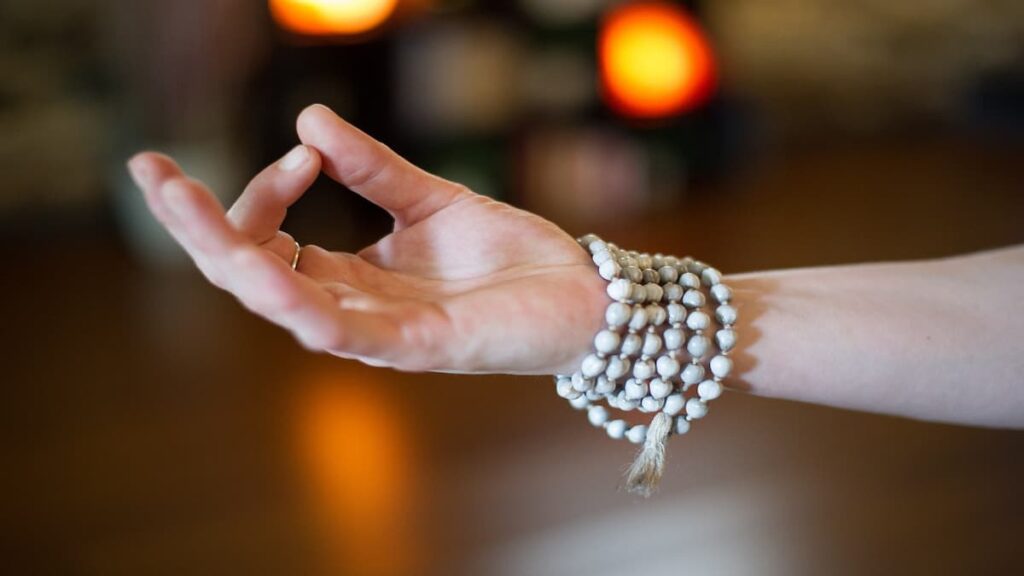Introduction
Chin Mudra is one of the hand gestures that are used during yoga poses and meditation. Hand gestures are Hasta Mudras in Sanskrit. Indeed, it is one of the most used Mudras in yoga and meditation. In practice, Hasta Mudras are used in different contexts in different use cases. In dances like Bharatha Natiyam, Hasta Mudra is a symbolic expression of a message.
Similarly, in Tantra Yoga like Srividya, it is a gesture communicating with the deity. Dasa Maha Mudras like Avahana, Avakunditha, etc., are ten important hand signs that are in use to worship a deity. So, in Hindu Iconographical portraits, the deities show specific Hasta Mudras like Apaya and Varadha Mudras. However, all oriental religions used Mudras in their rituals and practices. Gautam Buddha, Mahavira, and old Rishis and Yogis of ancient India used Mudras irrespective of their religions.
In practice, Hasta Mudras are used in Yoga and Meditation along with Yogic Kriya or Posture to attain the desired results. Likewise, Chin Mudra is a type of Hasta Mudra used in Yoga and Meditation. It has been practiced by Yogis and Rishis from time immemorial.
Furthermore, Ayurveda uses some hand gestures for therapeutic purposes. These therapeutic Mudras maintain the balance of basic elements in the body.
Apart from Hasta Mudras, other bodily and eye Mudras, and Bandhas are in usage of Yoga and Meditation to get specific results. Gheranda Samhita explains 25 such bodily or eye gestures. Many hundreds of Mudras are there and each of them belongs to a different type.
In this article, we discuss the meaning, steps, benefits, and variations of Chin Mudra.
Chin Mudra Meaning
Firstly, let us understand what is the meaning of Mudra. Mudam anandam dadati iti mudra. It means Mudra is the one that gives delight and pleasure. Yet, this is the literal meaning. It indicates the gesture or position, seal, or sign that gives the delight.
The Sanskrit term Chin is from the word Chitt which means consciousness. The nature of Consciousness is bliss. So, it is a hand sign that leads to the bliss of consciousness. Some people call it The Seal of Consciousness or Gesture of Consciousness. This hand sign helps the Self to realize the bliss of consciousness. That is why it always has a place in meditation. It helps to attain the goal of meditation which is the realization of the bliss of consciousness. Because of this, meditative yoga poses like Siddhasana, Sukhasana, Padmasana, etc. use this Mudra to get the maximum results.
The unfolded three fingers i.e. little finger, ring finger, and middle fingers indicate the three impurities of the soul. The index finger indicates Jiva or Jivatman (simply Atman) whereas the thumb indicates the Paramatman. The three impurities are Aanava (ego, I-ness), Kanma (Attachment to karma or actions), and Maya (Illusion). If the Jiva surpasses these three impurities, it becomes one with the Paramatman.
Chin Mudra Steps
Now, Let us discuss, how to perform Chin Mudra (the Seal of Consciousness.).
Sit in a convenient posture of meditation like Sukhasana, or Siddhasana. Keep the body straight so that your head, neck, and body are in a straight line. Then, close your eyes. Put your hands on your thighs as near as to the knees with palms facing upward. Thereafter, fold your index finger toward the tips of your thumb and touch it with the tip of the index finger in such a way it forms a circle. Meanwhile, keep the other fingers straight and close together. Meditate on your breath or thoughts or any other object of meditation. Prolong the meditation as desired.
Chin Mudra Benefits
The gesture of consciousness helps us to attain the state of elevated consciousness. In essence, this is the very object of meditation.
Also, it improves focus, awareness, and concentration.
Moreover, it restricts the Prana energy from going outward. It makes a circuit of Pranic energy that circulates internally.
It calms the mind and improves the sleep pattern. In particular, it relaxes the mind and relieves it from stress and tension.
Chin Mudra Variations
Instead of making a circle with the tips of the thumb and Index finger, the tip of the index finger touches the lower part of the thumb. Here, the concept is the philosophy of Dvaita. After surpassing the three impurities, the Jivatman surrenders the feet of the Almighty. Alternatively, when the tips of the thumb and index fingers are joined together, it denotes the Advaita philosophy wherein the Atman and Brahman are the same.
Chin Mudra and Gyan Mudra
Most often, Yogis use China Mudra and Gyan Mudra as synonyms. However, there are two variations as we have already mentioned. Some Yogis call one variation Chin Mudra and the other one Gyan Mudra.
Bottom Line
You cannot find a Yogi who does not use Chin Mudra for meditation. Because it is an essential hand and finger position which helps progress in Yoga and meditation. To conclude, let me quote two lines from Abhinaya Darbana, a classical Text on dancing.
Yato Hastas, tato dristihi Yato dristihis, tato manaha Wherever the hands are, the sights are also there Wherever the sights are, the mind is also there.
